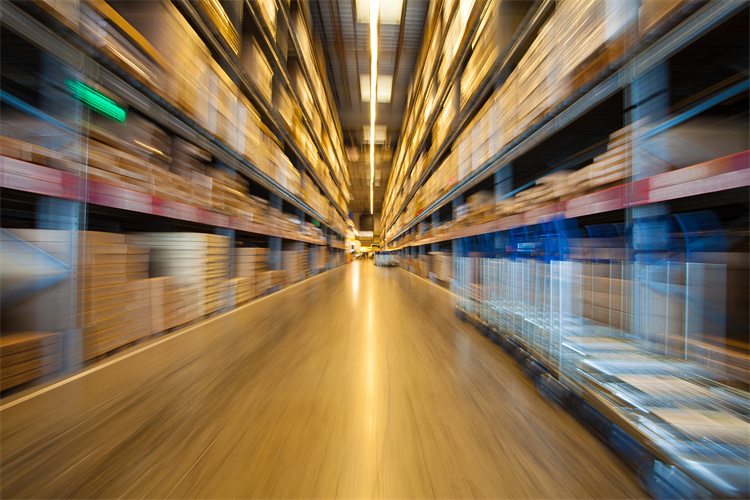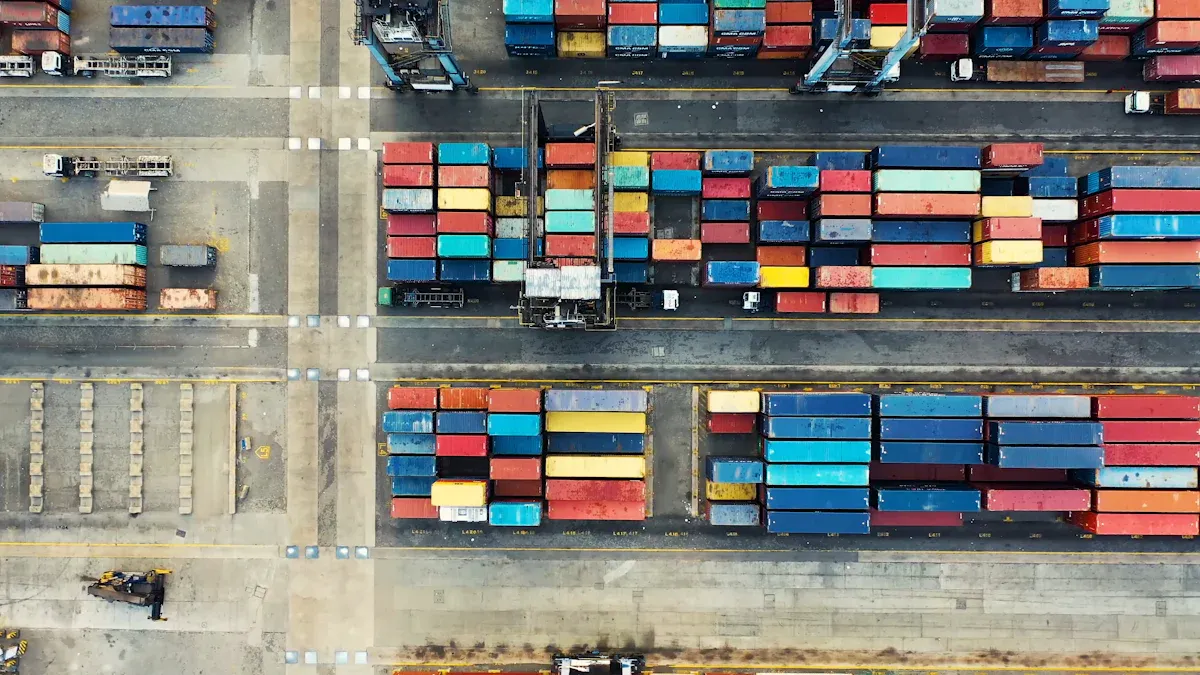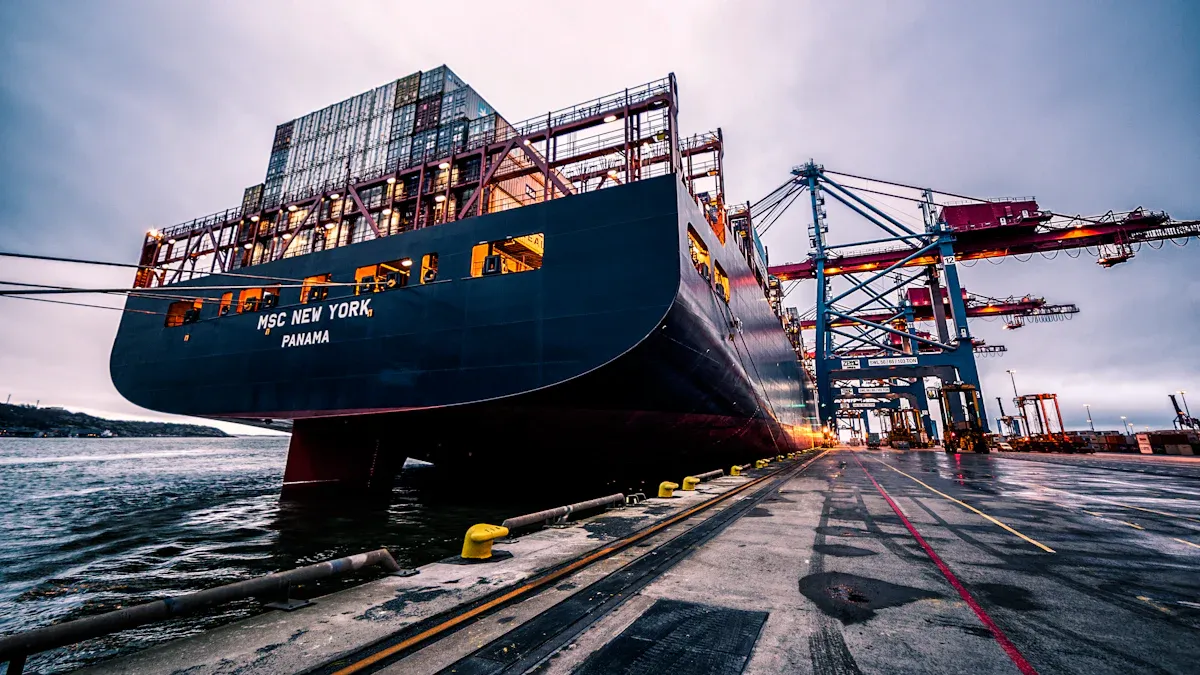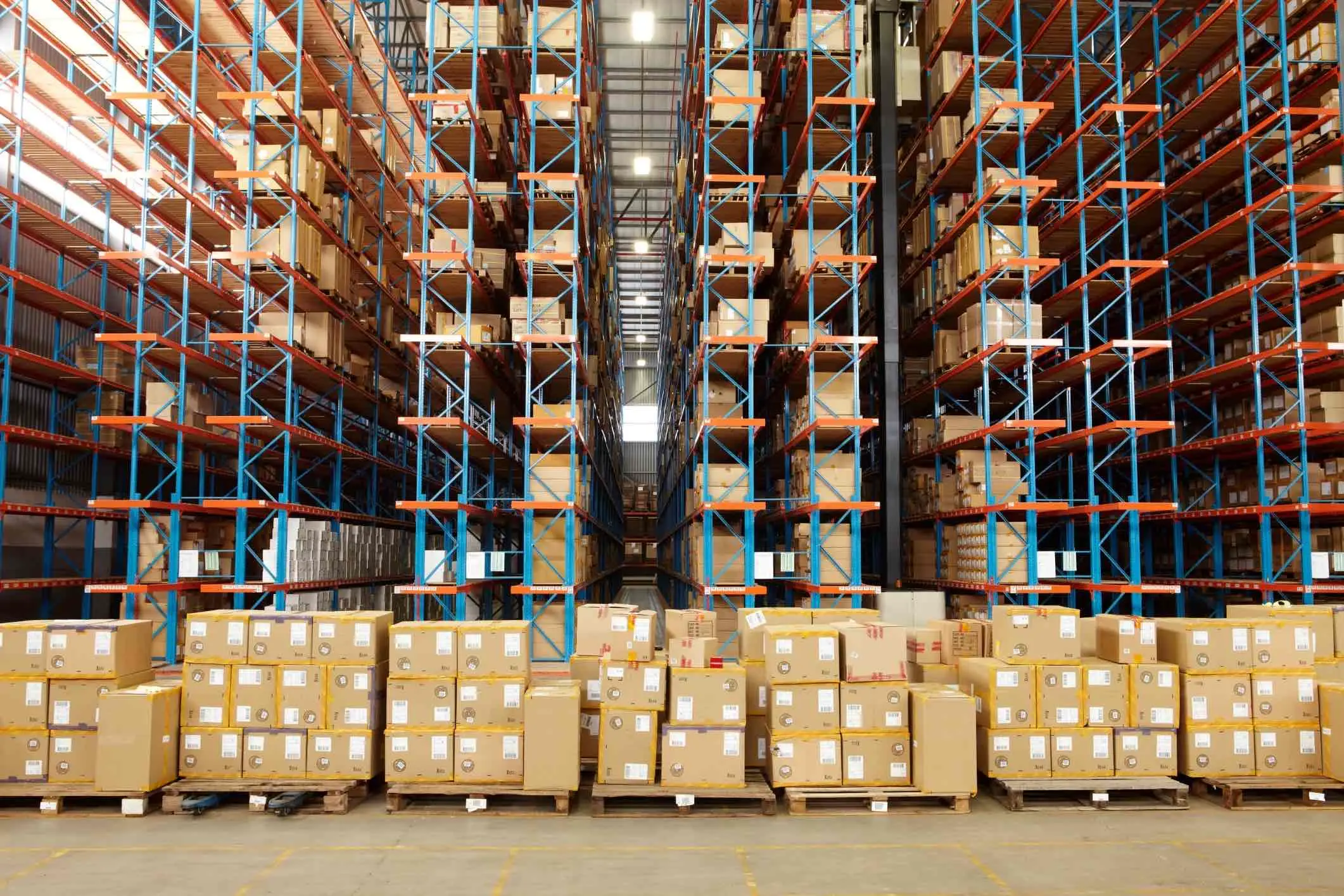Top Trends Driving Logistics Advancements in 2025

The logistics industry is undergoing rapid transformation, driven by digital innovation and emerging global logistics trends. You are witnessing a shift where logistics trends like automation and sustainability redefine operations. This digital transformation ensures businesses adapt to logistics industry trends, stay competitive, and embrace innovation in a fast-changing world.
Key Takeaways
Automation and AI are changing logistics by making deliveries faster. They also help save money. Use these tools to stay ahead.
Being eco-friendly is important in logistics. Use electric and hybrid vehicles to cut pollution and meet customer needs for green choices.
Use predictive analytics to spot problems in the supply chain early. This helps make deliveries more reliable and saves money.
Automation and AI in Logistics

Autonomous Vehicles and Drones Revolutionizing Delivery
Autonomous vehicles and drones are transforming logistics innovations by redefining delivery processes. These emerging technologies enable faster and more efficient deliveries, especially in remote areas. For instance, drones optimize last-mile delivery by reducing costs and improving inventory management. Autonomous vehicles, on the other hand, operate 24/7, increasing delivery capacity and minimizing delays.
Benefit | Description |
|---|---|
Reduced Delivery Times | Faster deliveries, particularly to remote areas. |
Optimized Route Planning | Enhanced operational efficiency through better route optimization. |
Enhanced Operational Efficiency | Lower last-mile delivery costs and improved inventory management. |
24/7 Operations | Continuous operation increases overall delivery capacity. |
Reduced Environmental Impact | Lower emissions due to optimized routes. |
These advancements in logistics trends highlight how automation drives efficiency and sustainability in the supply chain.
AI-Powered Supply Chain Optimization
AI is revolutionizing supply chain management by enabling smarter decision-making and operational efficiency. Machine learning algorithms analyze historical sales and external factors to optimize production schedules and distribution strategies. This reduces stockouts and improves inventory levels. AI-powered route mapping also enhances delivery speeds while lowering fuel consumption.
AI enhances data-driven decision-making, allowing smarter route scheduling and risk monitoring.
It reduces stockouts and optimizes inventory levels, positively impacting the supply chain.
Real-time data integration improves delivery efficiency and reduces operational costs.
Statistical data further supports these benefits:
Improvement Area | Statistic |
|---|---|
Equipment Downtime Reduction | |
On-time Delivery Rate Improvement | 5-10% |
Stockout Reduction | 20-30% |
Forecast Accuracy Improvement | 10-20% |
AI's role in logistics innovations ensures that you can adapt to global logistics trends and maintain a competitive edge.
Robotics Enhancing Warehouse Operations
Robotics is driving a significant transformation in warehouse operations. Fully automated warehouses use robotic systems for tasks like picking, packing, and sorting. This reduces human error and accelerates order fulfillment. Companies like Amazon and Walmart have already adopted robotics to streamline operations and eliminate bottlenecks.
Company | Robotics Implementation | Benefits |
|---|---|---|
Walmart | Partnered with Symbotic to automate distribution centers | Faster and more accurate order fulfillment |
Amazon | Introduced robots like Proteus and Sparrow for sorting and transporting packages | Reduced physical strain and improved operational efficiency |
By integrating robotics, you can achieve higher efficiency and accuracy in logistics operations. These technologies represent a pivotal innovation in the logistics industry, ensuring seamless supply chain management.
Sustainability and Green Logistics Trends
Electric and Hybrid Fleets for Eco-Friendly Transportation
Electric and hybrid fleets are transforming transportation by reducing emissions and promoting sustainable logistics practices. Battery electric vehicles (BEVs) emit half as much as traditional internal combustion engine vehicles (ICEVs) over their lifetime. Medium-sized BEVs produce 50% fewer emissions than ICEVs and 40% fewer than hybrid electric vehicles. By 2035, ICE cars will generate nearly three times the emissions of BEVs due to advancements in grid decarbonization.
BEVs reduce well-to-tank emissions by up to 75% in decarbonization scenarios.
Plug-in hybrid electric vehicles (PHEVs) purchased today emit 30% less than ICEVs, improving to 35% by 2035.
These technologies represent a significant step toward sustainability initiatives in logistics, helping you meet consumer demand for eco-friendly delivery methods.
Carbon-Neutral Strategies in Supply Chains
Carbon-neutral strategies are reshaping the supply chain landscape. Tools like carbon calculators allow businesses to measure emissions across operations, enabling actionable goals for reduction. Sustainable Aviation Fuel (SAF) solutions, such as GoGreen Plus, can cut greenhouse gas emissions by up to 80%.
Initiative | Description | Impact |
|---|---|---|
Carbon Calculator Tool | Assesses carbon footprint across operations. | Enables emission reduction goals. |
GoGreen Plus | Uses SAF to lower emissions. | Reduces greenhouse gases by up to 80%. |
Electric Vehicle Fleet | Invests in electric last-mile delivery vehicles. | Aims for 60% electric fleet by 2030. |
Adopting these strategies ensures your supply chain aligns with global logistics trends while meeting regulatory requirements like the Paris Agreement.
Circular Supply Chain Practices for Sustainability
Circular supply chains focus on reducing waste and reusing materials, creating a closed-loop system. Metrics like the percentage of recycled materials and the volume of returned products highlight the effectiveness of these practices.
Metric | Description |
|---|---|
Percentage of Recycled Materials | Tracks the proportion of recycled materials used. |
Volume of Products Returned | Measures products returned for reuse or recycling. |
Reduced Waste Generated | Evaluates the decrease in waste from supply chain activities. |
By adopting circular practices, you can minimize waste and promote sustainable logistics practices, ensuring a greener future for the industry.
🌱 Tip: Embracing sustainable logistics practices not only reduces environmental impact but also enhances your brand's reputation among eco-conscious consumers.
E-Commerce Growth and Last-Mile Delivery Innovations

Same-Day and On-Demand Delivery Solutions
The rapid growth of e-commerce has reshaped consumer expectations, making same-day and on-demand delivery essential. You now expect faster service, and businesses are responding by optimizing their logistics. Performance metrics like fill rate, on-time delivery, and time to ship highlight the importance of meeting these demands:
Fill Rate: Ensures immediate stock availability to fulfill customer needs.
On-Time Delivery: Tracks orders arriving as promised, building trust and loyalty.
Time to Ship: Reflects the speed of delivery, critical for same-day services.
Retailers are adapting to these trends. By 2025, 99% of them plan to offer same-day delivery to stay competitive. This shift aligns with the autonomous last-mile delivery market, projected to reach $45.27 billion by 2027.
Urban Logistics and Micro-Fulfillment Centers
Urban logistics is evolving to address the challenges of e-commerce expansion. Micro-fulfillment centers (MFCs) play a key role by positioning inventory closer to customers. This reduces delivery times and costs while lowering environmental impact.
Metric | Description |
|---|---|
Delivery Times | MFCs shorten routes, ensuring faster deliveries. |
Shipping Costs | Proximity to customers reduces transportation expenses. |
Environmental Impact | Shorter routes cut emissions, supporting sustainability. |
MFCs also improve delivery density and vehicle efficiency. By enabling more deliveries per trip, they reduce traffic congestion and fuel consumption. These innovations make urban logistics more customer-centric and environmentally friendly.
Advanced Delivery Methods: Drones and Smart Lockers
Technology is driving advanced delivery methods like drones and smart lockers. Drones offer contactless delivery, ideal for remote areas or urgent orders. Smart lockers provide secure, convenient options for customers who prefer flexible pickup times.
The rise of e-commerce expansion has increased demand for innovative delivery solutions.
Nearly two-thirds of consumers express satisfaction with parcel lockers, showing their growing popularity.
Companies like DHL have invested heavily in smart lockers, operating over 9,000 units globally.
These methods not only enhance customer-centric logistics but also reduce carbon emissions. By adopting drones and lockers, you can meet modern delivery expectations while supporting sustainability goals.
Blockchain and IoT Transforming Supply Chains
Enhancing Transparency and Trust in Logistics
Blockchain is revolutionizing logistics by enhancing transparency and trust among supply chain participants. Its tamper-evident shared ledger ensures that every transaction is secure and verifiable. This technology also supports environmental, social, and governance (ESG) tracking, helping businesses meet sustainability goals.
Description | |
|---|---|
Predicting supply chain risk | Helps identify and mitigate vulnerabilities in the supply chain. |
Enabling ESG tracking | Improves traceability for sustainability and compliance efforts. |
Enhancing trust | Builds confidence through secure, transparent data sharing. |
By adopting blockchain, you can strengthen relationships with partners and customers while ensuring compliance with global standards.
Real-Time Tracking and Monitoring with IoT
IoT technologies are transforming logistics by providing real-time visibility into supply chain operations. Sensors and connected devices track the location, condition, and estimated delivery times of goods. This allows you to anticipate delays, avoid spoilage, and optimize inventory.
IoT enhances supply chain visibility, enabling better coordination and decision-making.
Predictive maintenance ensures goods remain in optimal condition during transit.
Real-time tracking improves productivity and customer satisfaction by reducing uncertainties.
For example, IoT-based tracking systems allow you to manage just-in-time inventory effectively, reducing costs and improving delivery efficiency.
Smart Contracts Streamlining Supply Chain Operations
Smart contracts simplify logistics by automating processes like payments, compliance checks, and documentation. These digital agreements execute automatically when predefined conditions are met, reducing errors and delays.
Company | Application Area | Key Features |
|---|---|---|
Walmart | Food Safety | Tracks food provenance for quick source identification. |
Traceability | Ensures product quality from farm to shelf. | |
Supplier Management | Automates payments and compliance checks. | |
Maersk | End-to-End Visibility | Provides real-time shipping visibility for all stakeholders. |
Smart Contracts for Documentation | Automates creation and sharing of essential shipping documents. |
By leveraging smart contracts, you can streamline operations, reduce fraud, and enhance collaboration across the supply chain. These technologies ensure efficiency and reliability in logistics processes.
Supply Chain Resilience and Risk Management
Diversifying Suppliers and Nearshoring Production
Diversifying suppliers and nearshoring production are essential strategies for building a resilient supply chain. By sourcing from multiple suppliers, you reduce reliance on a single source, which minimizes risks from geopolitical conflicts, natural disasters, or tariffs. Nearshoring, or sourcing from nearby regions, further enhances stability by shortening lead times and improving responsiveness to market changes.
Statistic | Description |
|---|---|
Supply chain leaders implementing supplier diversification (2024 CIPS survey). | |
21% | Reduction in average lead time of production materials since July 2022. |
79 days | Average lead time of production materials in April 2024, still higher than 2019 levels. |
These strategies not only mitigate risks but also improve delivery efficiency, ensuring your operations remain agile in a dynamic environment.
Predictive Analytics for Risk Mitigation
Predictive analytics empowers you to anticipate and address potential disruptions before they occur. Companies like Amazon use predictive tools to forecast customer demand, ensuring efficient inventory stocking. Similarly, UPS leverages AI-driven analytics to optimize delivery routes, saving $400 million annually in fuel and labor costs.
Predictive analytics enhances decision-making by analyzing historical data and real-time trends.
Scenario planning through digital twins allows you to test strategies and assess risks without real-world consequences.
Adopting these technologies gives you a strategic advantage in managing supply chain disruptions.
By integrating predictive analytics, you can reduce costs, improve delivery reliability, and maintain a competitive edge in the logistics industry.
Building Agility to Adapt to Disruptions
Agility is critical for adapting to unexpected disruptions in logistics. You can achieve this by maintaining buffer stock, rerouting shipments, or sourcing from alternative suppliers. Tools that provide real-time visibility into your supply chain help you identify risks and respond proactively.
Performance Indicator | Description |
|---|---|
Ability to quickly adjust operations | Modify production schedules or reroute shipments in response to disruptions. |
Maintain buffer stock | Keep essential materials on hand to mitigate supply chain risks. |
Use tools for real-time tracking and risk identification. |
Continuous improvement methodologies, such as Total Quality Management (TQM), further enhance your ability to adapt. By focusing on agility, you ensure your logistics operations remain resilient and efficient, even in the face of challenges like cybersecurity threats or global shipping delays.
🚨 Note: Proactively addressing risks and maintaining agility not only safeguards your supply chain but also strengthens your ability to meet delivery commitments consistently.
Workforce Transformation in the Logistics Industry
Upskilling for Technology-Driven Roles
The logistics industry is rapidly evolving, and you must adapt to new technologies to stay competitive. Companies are investing in upskilling programs to prepare workers for roles like data analysts and AI specialists. These roles are essential as automation and data analytics become integral to operations. Poor data quality costs businesses an average of $12.9 million annually, emphasizing the need for skilled professionals in data management.
AI-driven forecasting reduces errors by up to 50%, improving operational efficiency. Virtual Reality (VR) training enhances knowledge retention by 10-15%, making it a valuable tool for employee development. Augmented Reality (AR) boosts warehouse productivity by over 40%. By embracing these technologies, you can enhance your workforce's capabilities and meet the demands of modern logistics trends.
Human-Automation Collaboration in Logistics
Automation is not replacing human workers; it is enhancing their roles. Collaborative Robots (Cobots) work alongside you, optimizing workflows and improving productivity. Automated Storage and Retrieval Systems (AS/RS) and Autonomous Vehicles (AVs) streamline repetitive tasks, allowing you to focus on problem-solving and decision-making.
This collaboration improves order fulfillment speed and accuracy. For example, integrating Cobots in warehouses creates dynamic environments where humans and machines work together seamlessly. These advancements ensure that you can handle complex logistics operations efficiently while maintaining high delivery standards.
Addressing Labor Shortages with Innovative Solutions
Labor shortages are a significant challenge in logistics. Innovative solutions like automation and on-demand labor help mitigate these issues. Automation reduces reliance on manual labor, while on-demand platforms provide flexible workforce options. Labor shortages impact transportation (67%), warehouse operations (56%), and planning (51%), according to a Descartes study.
Metrics like employee turnover rates and labor costs as a percentage of sales highlight the effectiveness of these solutions. By adopting these strategies, you can improve operational efficiency and maintain consistent delivery performance despite workforce challenges.
🔒 Cybersecurity Tip: As you integrate automation and digital tools, prioritize cybersecurity to protect sensitive data and maintain trust in your logistics operations.
JUSDA’s Role in Shaping Logistics Trends
Leveraging JusLink for Supply Chain Optimization
JusLink, JUSDA's intelligent supply chain platform, transforms how you manage logistics. It provides real-time tracking of inventory and shipments, ensuring you always know the status of your goods. The platform identifies potential risks early, allowing you to address issues before they disrupt operations. JusLink also uses dynamic inventory forecasting to predict future stock levels, helping you avoid shortages or overstocking.
With JusLink, you gain a unified platform to manage transportation services from multiple providers. This enhances visibility and control over your entire supply chain. By leveraging this technology, you can streamline operations, reduce costs, and improve delivery efficiency. JusLink exemplifies how JUSDA integrates innovation to shape logistics trends and optimize supply chain processes.
JUSDA Warehousing Solutions for Enhanced Efficiency
JUSDA's warehousing solutions redefine efficiency in logistics. With over 2.5 million square meters of global warehouse space, you can store and manage inventory with ease. Advanced systems like eVMI and JusLink enable real-time inventory tracking, ensuring transparency and control. These technologies reduce errors and improve order accuracy, enhancing your delivery performance.
Value-added services such as picking, packing, and labeling further streamline operations. Cleanroom facilities meet stringent environmental standards, making them ideal for industries like electronics and medical health. JUSDA's warehousing solutions ensure you can handle complex logistics demands while maintaining high standards of efficiency and reliability.
Industry-Specific Innovations by JUSDA
JUSDA tailors its solutions to meet the unique needs of various industries. For example, in the automotive sector, JUSDA leverages digital tools to enhance supply chain resilience. Its end-to-end supply chain management connects manufacturing to the end consumer, ensuring seamless operations.
In electronics, JUSDA integrates AI and digital platforms to optimize logistics. These innovations improve delivery timelines and reduce costs, helping you stay competitive. JUSDA's expertise in supply chain management demonstrates its commitment to driving innovation across industries.
🚀 Pro Tip: Adopting JUSDA's solutions can help you stay ahead of logistics trends and achieve operational excellence.

JUSDA Solutions
To provide you with professional solutions and quotations.
The logistics industry in 2025 will thrive on adaptability and innovation. Key trends include advancements in warehousing, cold chain logistics, and supply chain technologies. Businesses must embrace these changes to remain competitive. JUSDA’s solutions, like JusLink, exemplify how technology drives success, ensuring resilience and value realization in a rapidly evolving landscape.
